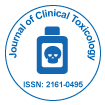
Journal of Clinical Toxicology
Open Access
ISSN: 2161-0495
+44 1478 350008

ISSN: 2161-0495
+44 1478 350008
Case Report - (2013) Volume 3, Issue 1
A 47-year-old woman was admitted to a local hospital 2 hours after the ingestion of 3000 mg methylphenidate, 360 mg duloxetine, 200 mg chlorprothixen, 400 mg quetiapin, 15 mg zopiclone, 60 mg mirtazapine and approximately 1 liter of strong alcohol (40% v/v). Her intention was suicidal. All the medication was her own prescription drugs except methylphenidate, which was prescribed to her 13-year-old son who was diagnosed with Attention Deficit and Hyperkinetic Disorder (ADHD). Due to Glascow Coma Score (GCS) 3 and the risk of aspiration she was incubated by the arriving Emergency Medical Service (EMS). Before intubation she presented slow reacting pupils. When arriving at the emergency room she presented dilated non-reacting pupils and increasing circulatory instability. The biochemistry of the patient (an arterial blood gas) revealed a metabolic acidosis pH 7.2, hypokalemia 3.2 mmol/L, blood glucose 3.0 mmol/L, standard base excess -8.7 mmol/L plasma lactate 3, 3 and hypocalcaemia 0.91 mmol/L.
Due to severe circulatory instability and troubling CGC level the patient was transmitted to the ICU for further treatment. Biochemical date revealed increasingplasma lactate levels increasing from 3, 3 to 4, 7 mmol/l (normal range 0, 5-2, 5 mmol/l) and sustained hypokalemia2, 7-3, 3 (normal range 3, 5-4, 6). Gastrointestinal aspiration was performed and 50 grams of Activated Charcoal (AC) instilled. The patient developed circulatory shock (blood pressure 60/30 mmHg, pulse 90) and was in need of vasopressors (Epinephrine 20-25 microg/ kg/min and Dopamine 3-6 microg/kg/min). Intravenous lipid emulsion (Intralipid 20%, Fresenius Kabi, Uppsala, Sweden) was dosed as 100 ml followed by 50 ml after 5 minutes. However, her condition deteriorated and the severity of the condition demanded advanced ICU support. The patient was therefore transferred to the nearest large facility hospital where Charcoal Hemoperfusion (CHP) were available. Blood samples were drawn prior, during and after CHP in order to quantify the efficacy of the intervention.
Charcoal hemoperfusion was commenced approximately 10 hours after the intended overdose. The patient was cannulated in the right jugular vein. After 4 hours of treatment with CHP and simultaneous hemodialysis (filters: Adsorba 300C, Gambro and HPS F8, FreseniusKabi, Uppsala, Sweden) at a blood flow of 200-300 ml/ min, the patient recovered to GCS 15 and became hemodymanically and respiratory stable. She experienced severe mental depression and verbally expressed continuing suicidal thoughts. Biochemical values for electrolytes and arterial gasses were within normal range. Although the patient’s plasma lactate had been high, this is correlated to high morbidity and mortality [1]. The blood concentration of methylphenidate (racemate) was cleared from severely toxic levels to below therapeutic concentration (Figure 1).
Postmortem methylphenidate concentration has been reported at levels from 0.310 mg/L (racemate) [2]. The therapeutic concentration interval is not uniformly described, but mean peak plasma concentrations of 0.0106 mg/L (D-methylphenidate) after a 54 mg dose (racemate) has been reported [3]. Methylphenidate elimination half life was 13.5 hrs during CHP (no 1) and 161 hrs between the two CHP treatments. Due to the sustained release formulation of the methylphenidate a second CHP was performed all though the patient was fully awake and circulatory stabile (Figure 1).
The patient was then discharged to a general ward for further psychiatric observation the following day.
The use of methylphenidate for various psychiatric conditions is rapidly increasing. In Denmark a more than six-fold increase in sold daily doses was observed from 2005 to 2010 (Figure 2) [4]. The Danish Medicines Agency presents data, which shows that the drug is mainly prescribed to youngsters, aged 10-14 with a second prescription top in adulthood in the range 30-39 years of age. Primary diagnosis for the users of methylphenidate is the ADHD patients [5].
Records at the Danish Poisons Information Center reveal a steep increase in inquiries regarding accidental and non-accidental consumption of large doses of methylphenidate, an increase that reflects the increase in sold daily doses [6]. The most common symptoms following methylphenidate overdose are agitation, tachycardia and lethargy. Severe toxicity from high dose intake includes cardiotoxicity, hyperthermia, mydriasis and neurologic effect ranging from agitation and confusion to CNS depression, seizures and coma [7].
The rationale of using CHP in preference of standard hemodialysis is further enhancement in the elimination of the absorbed toxic agents [8,9]. This in coherence with physiochemical properties of methylphenidate with a low protein binding 10-33% and a volume of distribution ranging from 1,8 to 2,65 l/kg depending on the isomer in question supports the use of CHP as the choice for extracorporeal removal technique used to increase the clearance of this xenobiotic [7].
Standard treatment with oral AC might be insufficient when large quantities of tablets are ingested. The laboratory test shows a small incline in methylphenidate concentration after CHP is commenced which can be explained by formation of a gastrointestinal pharmacobezoar leaking the active pharmaceutical agent to the blood. To our knowledge there are no previous cases or studies of full recovery from acute deep toxic coma to normal mental status after 4 hours of CHP, and no case reports on CHP use in methylphenidate intoxication.
The lack of effect from the intravenous lipid emulsion might have been caused by a combination of an insufficient dose for clinical effect and the only slightly lipophilic physicochemical properties of methylphenidate. The predicted log P value for methylphenidate is 1.47 but vary depending of methods of determination [10]. Though there are no standard methods available in the literature for intravenous lipid emulsion therapy, a higher dose than the patient received in the present case for cardiac resuscitation is suggested [11].
When treating methylphenidate overdose, practitioners should remain alert when the standard AC treatment is insufficient and think of the possibility of CHP assistance.